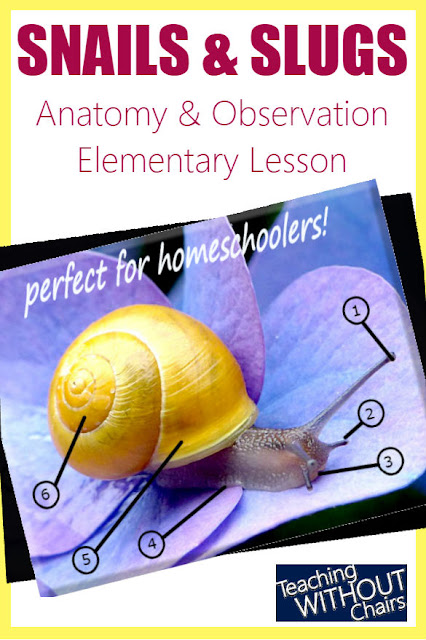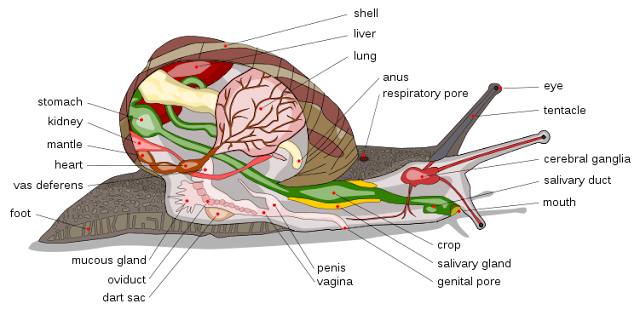Snail Anatomy + Snails & Slugs Science Homeschool Unit Study
Today's lesson plan {Snail Anatomy} is a sneak preview of my Snails & Slugs Science Unit Study! It's one of my fun homeschool unit studies--scroll to the very end to learn more about this unit!
One more thought on anatomy:
This snail anatomy lesson (and the whole snail unit) is perfect for elementary aged kiddos who would rather play with snails and check out their shells than simply read about food webs! You can learn A TON by doing your own investigating! So...here is...
Lesson 1: Snail Anatomy
& Observations
Science Topics: Scientific Method (observation,
predictions, analysis, critical thinking), sorting, senses & sensory
organs, comparing & contrasting, characteristics of objects and organisms,
physical characteristics
Supplies:
- Paper
plates, boxes, or something else to hold the snails you find
- A place to
find snails or slugs
- Snail
Anatomy picture & description (below in lesson)
- Optional: ruler, small scale (digital or balance), clear glass plate or pan, Snail Observation Lab
Part 1: Collection. Go outside and collect 10-20 (or as many as you can) snails
and slugs. Under wood or rocks is a great place to look! Place the snails and
slugs on a paper plate or in a cardboard box where you can observe them. Optional: If you set the snails on a
clear glass plate or pan you can see through the glass and look at the foot as
they crawl!
Part 2: Observation. Discuss the parts of the snail you can see. What do the shells look like? What are the snails
doing? How are they similar or different to each other and to people? What do
you notice about them moving?
Hint: If they aren’t moving, set them down in a warm, sunny spot.
Snails “hide” inside their shell when they are concerned about predators or if
the temperature is too cold. They “seal” themselves in with an “operculum,” but
can easily come back out when they feel warm and safe.
How big are they? Physical characteristics
or physical properties are things you can observe, like size, color, or
weight. What do you think the different parts of the snails do? How can you
sort them? (by physical properties like color, size, weight, etc)
Optionally, measure them with a ruler and/or a
scale.
Part 3: Anatomy. Use the image and information below to identify the eyes, nose
(if present), mouth, shell, and foot. If you have slugs, find the pneumostome.
What do each of these parts do? Which are unique to snails and slugs?
Optionally, fill out the Snail Observation Lab.
1- Eyes - at the tips of the long tentacles.
2- “Nose” - at the end of the short tentacles. The
tips of the second (smaller) pair of tentacles have olfactory glands on them
and work like a nose. Not all snails have them.
3- Mouth - near “bottom” of head. Even though it's in a spot you'd expect to find it,
the mouth can be tricky to find on very small snails. Look closely under
both tentacles! The mouth is just for
eating, not breathing!
4- Foot - the soft “body” of the snail. The foot is the big muscle that crawls along the
ground (or wall or plant...). It moves by contracting and expanding. It also has a gland to make mucus. Mucus smooths the path for the snail and
makes it easier for the snail to move.
5- Pneumostome - under the shell, easier to see
in slugs. The pneumostome is a small pore (or
opening) for breathing. The pneumostome connects to the snail's one lung
and lets the snail breathe. It is on the snail's right side, but it is
difficult to see the pneumostome because the shell often covers it. Slugs
also have a pneumostome in a much easier-to-see spot. The pneumostome can be opened and closed.
6- Shell - hard protective covering. The shell is the most stunning feature on a snail!
Some can grow quite big, some have gorgeous stripes, and some are very
plain. The shell grows with the snail.
New layers of shell are added on at the top of the opening where the
snail comes out of the shell, creating a spiral pattern as time goes by. In
order to make the shell, the snail must eat calcium. It usually gets
calcium by eating dirt.
Most kids want to know if their
snails are boys or girls. The truth is, most snails are hermaphrodites
(they have both male and female parts). Apple snails (also called Mystery
Snails) are a notable exception--they can change genders! Here is a
good explanation on how to identify apple snail gender.
Land Snail Internal Anatomy, for Older or
Advanced Kids:
Image Copyright
Information: By Original by Al2, English captions and other edits by Jeff Dahl
[GFDL (http://www.gnu.org/copyleft/fdl.html) or CC BY-SA 4.0
(https://creativecommons.org/licenses/by-sa/4.0)], from Wikimedia Commons:
https://commons.wikimedia.org/wiki/File:Snail_diagram-en_edit1.svg
Internal Anatomy Fun
Facts:
Heart: Snail hearts have two chambers: a ventricle and an atrium. There
is usually a blood vessel that connects the heart to the lung, but then the
blood circulates throughout the body, washing over the different organs without
going through blood vessels.
Lung: Land snails usually have one lung. Sea snails use gills to
breathe!
Cerebral Ganglia: This group of nerves is like a simple brain. Some snail species’
brains are more complex than others, and some snails have even been trained!
Scientists are even studying snails memories to learn more about human brains (read about
one study here)!
Mouth: Snail “teeth” are actually a special organ called the radula. It
is like sandpaper stretched inside the mouth. The radula is covered with very
tiny teeth that scrape food into the mouth while the jaw can break off chunks
or small bites.
Waste: Land snails reabsorb most moisture in their bodies, so they do
not urinate separately from solid waste. “Poop” comes out the anus on the side
of the shell and falls to the ground.
I hope you had a great time investigating snail anatomy!! This is the first lesson in the Snails & Slugs Science Unit Study. The unit includes 4 hands-on lessons and a set of printable bonus activities! It's perfect for homeschool families and co-ops. Click here to learn more!
Are you looking for more homeschool unit studies or themed units for elementary and middle school kids? Be sure to click here and check out our growing collection!
Happy Educating!
Carla & the kids who don't sit still


















0 comments